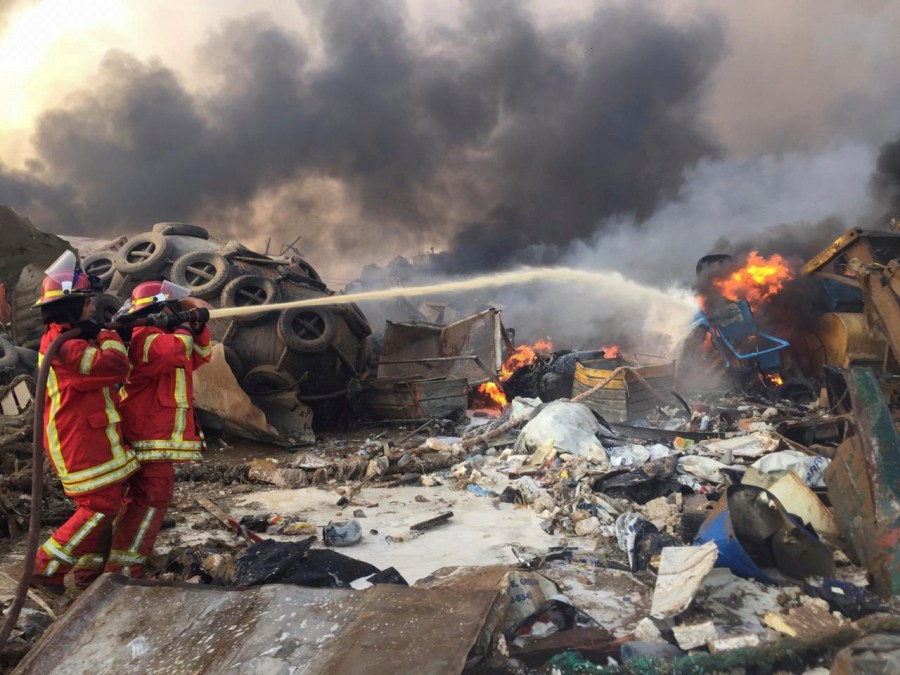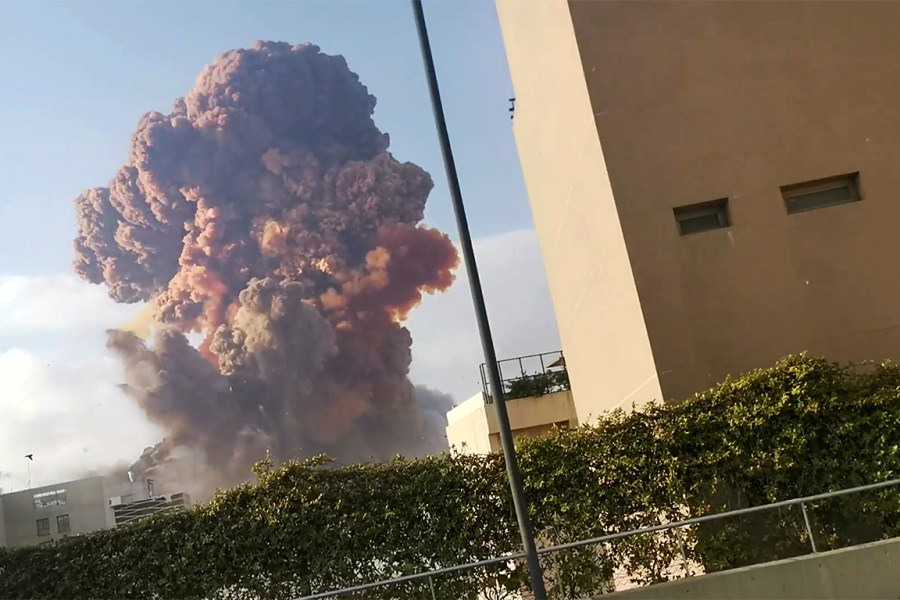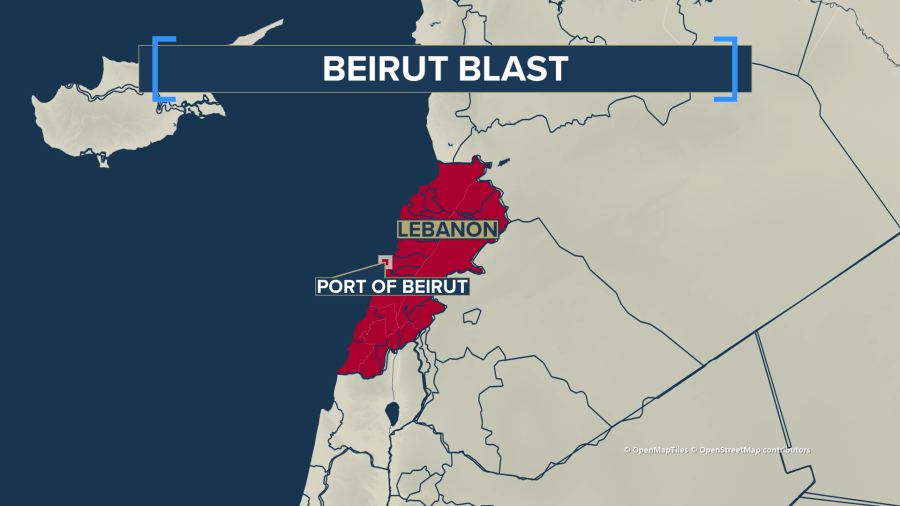Beirut reels from blast, as death toll climbs to at least 100
BEIRUT (News Nation) — Lebanese rescue workers dug through rubble on Wednesday looking for survivors after a massive warehouse explosion sent a devastating blast wave across Beirut, killing at least 100 people and injuring nearly 4,000.
Officials said the toll was expected to rise from the blast of highly explosive materials stored at port warehouses.
Lebanon President Michel Aoun said more than 3,000 tons of ammonium nitrate, used in fertilizers and bombs, had been stored for six years at the port without safety measures.
He called it “unacceptable.”

An official source familiar with preliminary investigations blamed the incident on negligence, Reuters reported.
“It’s like a war zone. I’m speechless,” Beirut’s mayor, Jamal Itani, told Reuters while inspecting damage he estimated ran into billions of dollars.
“This is a catastrophe for Beirut and Lebanon.”
Mayor Jamal Itani, Beirut
The head of Lebanon’s Red Cross, George Kettani, said at least 100 people had been killed.
“We are still sweeping the area. There could still be victims. I hope not,” he said.
The intensity of the blast threw victims into the sea and rescue teams were still trying to recover bodies. Many of those killed were port and custom employees and people working in the area or driving through during rush hour.
The Red Cross was coordinating with the Health Ministry to set up morgues because hospitals were overwhelmed, Kettani said.
Facades of central Beirut buildings were ripped off, furniture was sucked into streets and roads were strewn with glass and debris. Cars near the port were flipped over.
People walked around in shock, with helicopters overhead and teams searching for the missing at sea.
“This is the killer blow for Beirut, we are a disaster zone. My building shuddered, I thought it was an earthquake,” said Bilal, a man in his 60s, in the downtown area.
Officials did not say what caused the blaze that set off the blast. A security source and media said it was started by welding work being carried out on a hole in the warehouse, Reuters reported.
Fireworks, ammonium nitrate likely fueled Beirut explosion
Fireworks and ammonium nitrate appear to have been the fuel that ignited the explosion, suggest experts and videos of the blast.
The scale of the damage — from the epicenter of the explosion at the port of Beirut to the windows blown out miles away — resembles other blasts involving the chemical compound commonly used as an agricultural fertilizer.

But the compound itself typically doesn’t detonate on its own and requires another ignition source. That likely came from a fire that engulfed what initially appeared to be fireworks that were stored at the port.
Online videos of the disaster’s initial moments show sparks and lights inside the smoke rising from the blaze, just before the massive blast. That likely indicates that fireworks were involved, said Boaz Hayoun, owner of the Tamar Group, an Israeli firm that works closely with the Israeli government on safety and certification issues involving explosives.
“Before the big explosion, you can see in the center of the fire, you can see sparks, you can hear sounds like popcorn and you can hear whistles,” Hayoun told The Associated Press. “This is very specific behavior of fireworks, the visuals, the sounds and the transformation from a slow burn to a massive explosion.”
Jeffrey Lewis, a missile expert at the Middlebury Institute of International Studies in Monterey, California, offered a similar assessment.
“It looks like an accident,” Lewis told the AP. “First, there was a fire preceding the explosion, which is not an attack. And some of the videos show munitions what I could call popcorning, exploding like ’pop, pop, pop, pop.’”
He added that “it’s very common to see fires detonate explosives.”
“If you have a fire raging next to something explosive, and you don’t put it out, it blows up.”
Jeffrey Lewis, missile expert at the Middlebury Institute of International Studies
The white cloud that accompanied the massive blast appeared to be a condensation cloud, often common in massive explosions in humid conditions that can follow the shock waves of an explosion, Lewis said.
Orange clouds also followed the blast, likely from toxic nitrogen dioxide gas that’s released after an explosion involving nitrates. Experts should be able to determine the power of the blast by measuring the crater left behind, which appeared massive in aerial footage shot on Wednesday morning by the AP.
‘Brought back the vision’ of US embassy attack

The blast was heard as far away as Cyprus, a Mediterranean island about 100 miles across the sea from Beirut.
The port district was left a tangled wreck, disabling the nation’s main route for imports needed to feed a nation of more than 6 million people. Lebanon has already been struggling to house and feed hundreds of thousands of refugees from Syria.
“The blast blew me meters away. I was in a daze and was all covered in blood. It brought back the vision of another explosion I witnessed against the U.S. embassy in 1983.”
Huda Baroudi, a Beirut designer
The U.S. embassy in Beirut, which moved to another part of the city after the 1983 attack, warned residents about reports of toxic gases released by the blast, urging people to stay indoors and wear masks.
Footage of the explosion posted on social media showed a column of smoke rising from the port, followed by an enormous blast, sending a white mushroom cloud and fireball into the sky. Those filming the incident from tower blocks as far as one mile from the port were thrown backward by the shockwave.
The explosion came three days before a U.N.-backed court is due to deliver a verdict in the trial of four suspects from the Shiite Muslim group Hezbollah over a 2005 bombing that killed former Prime Minister Rafik al-Hariri and 21 others.
Hariri was killed by a huge truck bomb on the same waterfront, about one mile from the port.

Pope Francis offers prayers for Beirut victims
Pope Francis has offered prayers for the victims, their families, and for Lebanon.
The pontiff appealed that ‘’through the dedication of all the social, political and religious elements,’’ Lebanon “might face this extremely tragic and painful moment and, with the help of the international community, overcome the grave crisis they are experiencing.’’
International aid is heading to Beirut, with Poland sending a team of about 50 firefighters, including 39 rescuers with 4 dogs and a chemical rescue module. A Greek military transport plane is heading to Lebanon with a search and rescue team with specialized equipment and a sniffer dog, while Cyprus says it will be sending help.
Reporting by Ayat Basma, Samia Nakhoul and Ellen Francis; Writing by Dominic Evans, Ghaida Ghantous, Tom Perry; Editing by Edmund Blair at Reuters. Reporting by Jon Gambrell and Josef Federman at the Associated Press.









